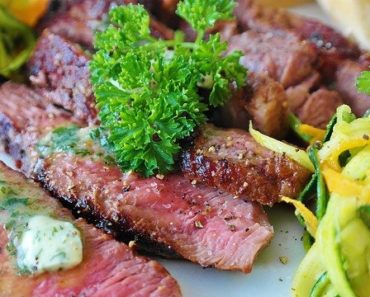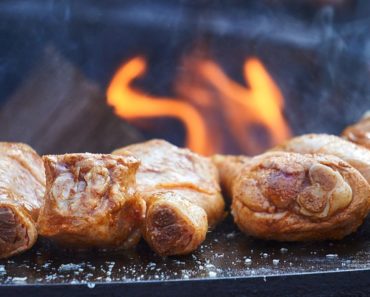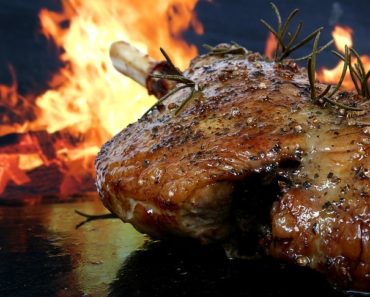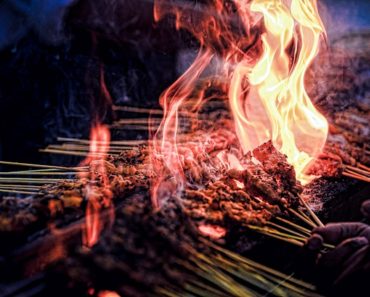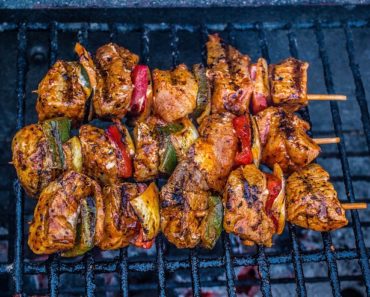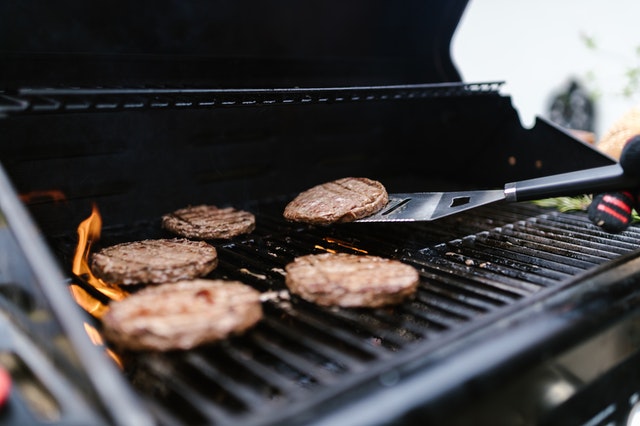
Can I Grill Inside My Garage? Grilling Safety Tips
Can I grill inside my garage? Whether you live in a condo, apartment, or house, the one thing all of us have is some kind of garage. But what if your grill doesn’t fit? Can you grill inside your garage? The answer to that question may depend on the size and type of your garage. If it’s big enough and has access to natural light. You can use the space as an extension for the grilling season.
It’s grilling season and you may be wondering if it’s safe to grill inside your garage. You can grill inside your garage. It is even common for people to do so in the winter months when it is too cold outside and they want to grill something fresh. There are a few things that you need to keep in mind as far as safety goes but if done correctly this could be a great way to enjoy yourself and cook some food on those colder days! The thing you need to do when considering if you can grill inside your garage is to know what types of fuel the grill uses. Most traditional gas grills use propane or natural gas as an energy source- these types of grills cannot be used indoors because they produce carbon monoxide which is dangerous for people and pets. A charcoal briquette or wood burning grill would not pose this problem but it’s also important that there’s proper ventilation in the area where you’re cooking.
Table of Contents
Consider is the size of your grill and whether or not it will fit into your garage?
Can I grill inside my garage? The first thing to consider is the size of your grill and whether or not it will fit into your garage. If you have a smaller grill, you can use a small table as an outdoor extension for grilling on the inside.
If you’re in need of an outdoor grill, then this is even more important. There are compact grills that don’t take up too much space and they still deliver good results when it comes to grilling food, so if you have little storage space, don’t worry about it.
If you prefer charcoal over gas or vice versa, these kinds of things can also be determined at this time. What kind of cooking method do you intend on using? Do you want to use wood chips or chunks for smoking food? The next thing would be looking into your available fuels for grilling depending on how serious of a barbecue enthusiast you are. If you’re not, then propane is fine. It’s easy to control the temperature and its clean-burning nature means that the flavor of your food won’t be affected by any contaminants that are found in fuels like gasoline or natural gas. If you are into something more sustainable, then you can look into wood pellet grills which use small pieces of compressed hardwood for fuel. These pellets are put together using different kinds of woods so if you want a specific flavor for your food, it’s best to know what kind of wood you should have used during pellet production so that it will turn out just right once it reaches your grill.
These three kinds of cooking methods will determine what kind of utensils you’ll need to bring with you to achieve the best results when it comes to grilling your food. Rotisserie-cooked food has that nice smoky flavor which makes it more distinct compared to other types of barbecue. Direct flame is typically used for searing meat which locks in its juices before it’s flipped over or away from the heat source. Other than that, there are also other ways that people use for cooking barbecued food like smoking their meats low and slow over hickory chips or chunks, and moist fire cooking.
Next thing you have to think about is your budget. This should be done after deciding on which type of cooking method you’ll prefer. If there’s a specific kind of grill that you want, then it’s best to see if the price matches what you can afford because nobody wants to have an expensive equipment laying around collecting dust rather than being used for its intended purpose. Once this is done, look into getting some grilling accessories that go with your preferred cooking method or just basic utensils like tongs, forks and spatulas which are usually included in most barbecue sets anyway, so don’t worry too much about getting those right off the bat. The final things to consider would be the kind of grilling you want to do. Will it just be a small get together with family and friends or will it be a big event outdoors? There are different kinds of barbecue pits that can cater to your specific cooking needs which brings us back to our original point. Just think about what works for you and try not to forget anything that could make things easier when it comes time to actually setting things up and cooking your food. It doesn’t have to be difficult, since you can make everything yourself.
Can I grill inside my garage? If you have a smaller grill in your garage, you can use a small table as an outdoor extension for grilling on the inside or cooking on the outdoor grill for the entire family. With a few modifications, you can convert an existing table into a barbecue party just like that.
You will need: A small table with or without legs, Silicone caulk or Outdoor sealant, Clear waterproof wood finish, Metal grills and Screws with the length depending on the thickness of your tabletop. Tools: Screwdriver, ruler, pencil, clamps, silicone gun and silicone tubes. In addition to these items here’s some more tools but they are optional: Drill, sandpaper and larger clamps.
Step 1: Disassemble the table. Remove all screws from the bottom of the tabletop so you can get it off the frame. Do not try to lift the tabletop if it’s still attached to the frame.
Step 2: Design your grille. To determine where your holes should be, place a metal grate over a sheet of paper and mark out a grid with pencil. The grids will show you where each hole is placed – this will make drilling much easies! Make sure that there is enough space between each hole for air circulation! Using these measurements mark out your grid on the tabletop. Once you have marked out your grid on the tabletop, drill some holes from underneath with a 3mm bit to make sure they are placed correctly . Here’s a tip: clamp the table together with the frame and secure it from above using an additional clamp – this will hold everything in place while you drill.
Step 3: Caulking the tabletop. The tabletop is going to be sat on most of the time, so we want to make sure that there are no gaps between the grille and table ! Using a caulk gun, apply silicone caulk around all four edges of each hole. Allow for 24 hours rest before continuing. We recommend waiting a few days before stacking anything heavy on top until fully cured.
Step 4: Apply a clear waterproof wood finish. We recommend using a clear waterproof wood finish with UV protection to protect from outdoor elements & spills when in use. Wait for the caulk to dry, then apply two coats of your chosen finish with a paintbrush – be sure to allow enough time in between coats for drying. Allow 24 hours before stacking anything heavy on top .
Step 5: Adding Grill Frame – If adding grill frame, use screws and clamps to secure the grill until fully secured into place. Attach metal grille to tabletop using long screws or sheet metal screws. Be careful not to over tighten so you do not crack the tabletop. Seatback should be snug!
You may like this: Top 7 Best Smokers For Beginners
What are the benefits of grilling inside your garage?
We all know that grilling is supposed to be enjoyable. But let’s face it…if you don’t have an outdoor space for cooking, the act of grilling can be downright miserable. One alternative to this is to grill inside your garage! Here are some of the benefits: You can use more powerful heat sources, like propane or charcoal instead of using expensive electric appliances-you get better results on your food because you’re cooking with heat that behaves more like outdoor heat. If you’re hosting a party, everyone will love coming over and hanging out in your awesome new indoor grilling space. There’s no worry about rain or wind messing up the grid on your gas grill. Your neighbors won’t complain about smoke drifting in their direction from your barbecue and You have a place to store all the stuff you need for grilling, too.
Can I grill inside my garage? What are some things to consider when deciding whether or not to grill in your garage? It’s important to make sure that any toxic fumes like propane and natural gas don’t leak into the rest of the house. Make sure that nothing is flammable near where you’re going to be cooking, like paper, rags, paint, so on.
If you’re using charcoal or other forms of open flame, be mindful of home security. You may want to invest in an automatic light sensor so that if anyone tries breaking into your garage they’ll get blasted with light and hopefully scare them away. Light and ventilation might be an issue. Adjust your grill controls to account for this and if you’re cooking with something like propane, make sure all your doors and windows are open for ventilation. And prepare the area beforehand by moving any important tools or anything that may get damaged or dirty out of the way.
There is a lot of equipment involved in indoor grilling, so first let’s go over the essentials: Firstly, Grill. Of course you’re going to need some sort of grill surface for cooking, which can either be electric or gas powered. One popular option is a small counter top electric grill, which can be used indoors or outdoors. Secondly, Grill Surface Thermometer. You want to make sure you’re cooking at around 350-450 degrees Fahrenheit (176.7-232.2 Celsius). Thirdly, Oven mitts and Pot holders. These are essential in keeping you safe while grilling. Try to buy some heat resistant oven mitts for when your grill is really cranking. Finally, Fire extinguisher. You never know when something might go wrong, so it’s important that you have one handy in case things get out of hand.
Now let’s move on to the stuff that makes indoor grilling special: Firstly, Charcoal chimney starter or Electric charcoal starter. This device is used to light your charcoal fire. It basically does it for you with less hassle and fewer fumes. Secondly, Electric griddle – A griddle gives you a lot more options than just using the grill surface on your grill. Now you can make foods like pancakes and eggs! Thirdly, Cast iron skillet or Grill press – These are essential in giving grilled foods those nice looking cross hatch patterns. Next, Grill Basket – This is great for veggies or other small items that tend to fall through the grates of your grill. Finally, Indoor grill food rack – These are great for keeping your food from falling through the grates as you’re taking it on and off of your grill.
Why would you want to grill in your garage?
Can I grill inside my garage? Grilling is a fun hobby for many people, however the weather often gets in the way of being able to do it on a regular basis. It’s either too cold or too hot outside to be comfortable standing over an open flame. So what are your options? Go inside where it’s warm and see your indoor grilling options here ? Or perhaps just give up grilling all together until the good weather returns?
I am one of those people who still yearns to cook outdoors even when there’s snow on the ground. But I didn’t feel like spending hundreds of dollars this winter building an outdoor kitchen with propane and a grill when I could just as easily go out to my garage and use the same propane tank. The only difference is that instead of standing over an open flame, I would simply close it in with a sheet of metal and a thermometer.
While most people would agree that grilling is one of the best parts about summer, not everyone has access to an outdoor grill. Having your own personal grill allows you to grill year-round even in the winter! And entertaining options are endless; everything from mouth-watering hamburgers and hotdogs at your next backyard barbecue to spicy shrimp kabobs on a cool autumn evening. Some things just taste better on the grill – no matter what time of year it is!
If you don’t happen to live in an apartment or anywhere near one with access to a BBQ, fear not; there is hope for those of us who dream of throwing some meat on the grill. That hope comes in the form of making your own backyard grill out of found materials that can be easily assembled and disassembled without damaging your garage walls, floors or ceiling.
Lighting a new grill in the garage. Now, of course you can’t just light your grill up inside your garage and expect to get any kind of good cooking results. This item has been sitting idle since last winter so it should be ready for a little action today. You can also use small propane or butane torch if you happen to have one that’s kicking around the garage somewhere. Since this is an electric starter, I will need an extension cord in order to provide power to the unit while it warms up. The goal is not only warmth but also a small controlled flame to get the starter burning. Once we have a nice little fire going, we can change out the log and replace it with a good piece of lump coal or charcoal that will provide us with enough radiant heat to begin cooking.
Warming up your grill. For this initial warming period you will want to keep the lid closed and let your ingredients come up to room temperature if they were frozen when you put them inside. If not, then let them warm on the counter for about 45 minutes before placing directly onto the grates or skewer sticks. Remember to use all of your safety precautions so no one gets burned in the process of trying something new! I’ll be using my indoor stovetop in order to cook these items until I can get the grill warmed up. Once this is complete, I’ll simply set my grates into place and then place the items that were cooking on top of them to begin searing your food.
An additional item you could use for warmth would be a small butane camp stove which are becoming extremely popular around camping areas everywhere due to their efficient design. This model operates with two simple controls; one knob provides ignition while the second knob will adjust the output temperature for cooking or heating purposes depending on how far it’s turned. If you’re needing to keep your garage warm during the winter months then simply leave this running as long as necessary.
See more: 10 Best Indoor Smokeless Grill Consumer Reports 2022
What is the best way to grill inside your garage?
Can I grill inside my garage? The best way to grill inside your garage is to cook out on the concrete floor. It helps keep the heat off of you and spread it out all over your garage. Plus it makes a good place for people to sit while they wait for the food. That’s a great idea! People can sit on my concrete floor while I get them some food from my freezer. What if they get grease on my new floor? Or what if there is a spill and I have no paper towels to clean it up with? Or worst of all, what if someone gets hurt?
This electric grill has many nice features: It comes with an adjustable height mechanism so you can choose to grill directly on your concrete floor or give yourself some extra room and cook off of those paper towels that you just bought because now there’s no place to sit down now that you have spilled oil all over your concrete floor. And, The grease catcher will keep the grease from falling onto the ground, which means that you can now have fun at your next party without having to worry about the oil spilling out of the garage and making it look like a crime scene.
Can I grill inside my garage? What is the best way to grill inside your garage? Well, there are plenty of options depending on your garage’s layout and available space. You can hang up a small sized grill by the chimney with chains, mount it over the hood or trunk of your car, build a shelf for it to sit on whatever works best.
A word of advice when buying any used grills, they usually have some sort of damage from being knocked over when hot or from people kicking them while searching for tools. You will need to fix it when building the toolbox so you want to avoid these things when looking at a toolbox that has a grill inside it already. In our case there were two broken spots where the bottom had been kicked off and was just glued back on instead of being replaced. I would also remove any flammable padding that may be glued to the lid, this will start your toolbox on fire if you cook it too long or have a hot ember fall in there! Once you have everything together all you need to do is nail down your boards so they are flush with each other and drill holes for where your grilling or smoking tools go. The only thing left now is paint or stain it whatever color you want, however I recommend letting the wood age naturally at least six months after building it into a grill before staining or painting it because greases from cooking can often leave stains no matter what kind of paint you use. One last step then is to put a few old boards underneath the grill just in case it ever leaks grease through the bottom into your garage below, not that it should but it’s a good idea to have them there anyway.
Now you have a very nice looking piece of furniture that nobody will suspect is a smoker or grill. Just make sure to get one big enough for what you want to cook, these things can get pretty hot so be careful when trying to smoke something large inside this toolbox grill. And if you are grilling something too large for this one, here is how we made our small turkey-sized to hang from the chimney of our grill.
The next step is to put some lighter fluid on some newspaper or whatever you like and light it on fire inside the toolbox box, once it starts burning all of your wood boards will soon be on fire! You want this to happen because the heat generated by the flames seasoning the wood will make for a much more flavorful BBQ than if you did not use fire at all. Once this is done just wait about 20 minutes or so until you do not see any more smoke coming up through the cracks then unplug it and let it cool down completely before using your brand new backyard smoker or grill! Oh yeah, one last thing, always wear gloves when handling any scorching hot grill or smoker because the handles will get so hot you will not be able to touch them without burning yourself.
Do you protect yourself from fumes while cooking in a closed space like a garage?
This question comes up fairly often so here are some thoughts on this subject. First let me say that I have cooked many times over the years in my own home or others’ homes where we had little or no idea as to what type of fumes were coming out of the stove burners. Sometimes it was gas, kerosene or petrol and sometimes it may have been wood or coal and so on. We just didn’t know. No problem, except for possibly carbon monoxide poisoning. Now let us suppose that you are using gasoline or some other type of petrochemical fuel to cook inside your home – not a good idea at all! When you put any type of organic material into an open flame there is always off-gassing of fumes – they smell bad too!
The most obvious example being when lighting a match or candle with sulfur content in the match or wick. So when you smell the fumes from your petrochemical fuel burning under your cooking pot that is just what it is – off gassing of these petrochemicals into the air inside your home. There are many other organic materials used in various products ranging from waxes to sealants, newspaper, cardboard etc. If you can smell it while burning…it’s not good for you. Putting any type of organic material including food scraps into an open flame is never a good idea because of off-gassing into the air that may contain benzene or other toxic chemicals – even gasoline itself has some potential toxicity.
Can I grill inside my garage? There are many reasons why it is never a good idea to cook with gasoline indoors ever! But there have been times when I was out camping or fishing in some very remote location where burning gasoline was our only means of cooking. It has its problems though, including the strong odor of the petrochemicals which permeate your clothes and stay on your skin all day long. Chemical-pure and other types of purifiers can be used to somewhat reduce these petrochemical odors but it is still not a good idea.
Now let’s talk about carbon monoxide poisoning. This can happen when burning any fuel inside an enclosed space such as a garage or even in the basement of your home – with little ventilation, if any at all. When you burn organic material such as gasoline, wood, coal and so on, the products are water vapor -H2O, carbon dioxide -CO2 plus partially oxidized waste materials called Tar which are carcinogenic substances that are bad for us humans to breathe – especially over extended periods of time. Normally there should also be some fresh air coming into the mix to provide us with oxygen as well. If too much carbon monoxide is present then you better turn off the fire and get out of there fast. Carbon monoxide can kill you without you even knowing it! And since it is odorless, tasteless and colorless – it can build up to toxic levels before anyone even knows what’s happening. The only way to detect its presence is through a suitable CO monitor or alarm device.
Let me talk about gasoline specifically. This stuff really stinks bad so it makes no sense whatsoever to go ahead and use that type of fuel indoors where at least one or more windows need to remain open continuously in order to release these petrochemical fumes.
Gasoline also has the added danger of being very flammable. You need lots of heat to begin burning gasoline, which is another reason why it is not a good idea to use this fuel indoors under any circumstances. So how would you go about using gasoline as an indoor cooking fuel? A better idea would be to pour some gasoline into a small metal container such as an old coffee can or something like that and then set up a fan near the opening of this container which is blowing air into the container. Then light a small fire inside this can with your cooking utensils on top, quickly turn on the fan and stand back! The resulting inferno will make short work of any organic material placed atop it and you’ll still get all those cancer-causing chemicals we talked about earlier; only now they are being oxidized instead of just releasing petrochemical fumes. So let’s summarize…it is not a good idea to cook with gasoline, charcoal lighter fluid or any other flammable petrochemical products indoors – ever!
Do you protect yourself from fumes while cooking in a closed space like a garage? Do you need some sort of hooded room air cleaner fan system to keep the air breathable around your grill? Or do you just go outside because it’s better there anyway? Yes, I use my gas mask. It protects me from fumes and is comfortable to wear for hours at a time. It’s also great that there are two filters, so it doesn’t have to be cleaned as often during long cooking sessions. I would never cook in an area where I couldn’t protect myself with a filter mask – I don’t want carcinogens anywhere near my food!
Read more: Top 7 Best 5 Burner Gas Grill Review
Do I need ventilation for my grill when cooking indoors?
The answer to this question is simple, “Yes.” The choice of ventilation will have a great impact on the amount of smoke and temperature you will create in your garage. If you are not familiar with how ventilation systems work, consider asking for assistance from someone who has experience with these types of home appliances. Not having the appropriate level of ventilation can result in carbon monoxide poisoning or fire hazards. You must have adequate ventilation for your grill type and desired use. It’s important that any gas piping is sufficient for installation purposes as well as serviceability. Any large commercial range hoods would be suitable for both settings, but if using inside an apartment or condo, make sure the size meets local code requirements and installation begins.
Numerous models are available for both types of ventilator systems; some are simple exhaust fans, while others operate on the same vacuum principle as your car’s engine.
The last thing you need to understand is how a range hood works, which will help you with your ventilation choice. The process is simple: air enters the appliance through an intake located on the bottom of the unit, then cools and collects grease particles as it travels up and outside your home via an exhaust pipe that leads to the roof or chimney flue. One important step in this design is having a filter between these two stages to catch most of the unwanted dirt before it becomes airborne. Also included are charcoal inserts for those who smoke indoors for smell absorption, although they only work when enough heat is provided by gas or electric stovetops.
How to keep grilling safe in your garage?
Can I grill inside my garage? Garages are great spaces for storing cars, tools, and grills. Unfortunately, they can also be the site of many grill accidents. With summer here it’s time to take proper precautions so that you can enjoy your garage barbecue without worrying about injuries or other problems. Grilling accidents have been on the rise over the last decade due to an increase in grilling activities during the summer months. Many of these injuries occur because grills are placed in the garage to keep them out of reach of children and pets. But there are still precautions that need to be taken by homeowners.
Proper storage is key. When it comes to safety, the garage storage is no different than outdoor use. The three leading causes of death from grill fires reported were: failure to clean up grease other flammable liquids; failure to store grill properly; and placing the grill too close to a house. Grills are always getting hotter, larger, and with more burners. Although this makes them more efficient, it also increases the likelihood of fires. A large number of these injuries occur because people don’t take proper precautions when using a grill in a garage setting.
Keep your grill on a level surface at least three feet away from anything flammable and make sure that when you grill in the garage, there’s plenty of ventilation. A few house plants will help with the smell, but be wary of sparks and embers. In addition to safety precautions at home, there are several other things you should remember when grilling this summer such as never barbeque if you have been drinking alcohol. And, Have a water supply nearby in case of an emergency.
Don’t leave flammable materials near open flames. Grilling produces sparks that can ignite paper, rags or other objects within range of the heat source. Don’t store flammable products like gasoline, kerosene, charcoal lighter fluid or aerosol cans in your garage; you may also want to remove flammable items from your propane tank storage. If you have a flammable item that must be stored near a grill, position it away from the heat source.
Can I grill inside my garage? Build your fire in a metal container. Use a metal tub or other fire-safe container for grilling if you are barbecuing on sand, grass or any other area where sparks could ignite surrounding combustibles. If building an above ground fire pit for grilling, place stones around the perimeter to contain the flames and prevent embers from flying out of the pit.
Position the grill at least 15 feet away from walls and roofs. The lid of your grill can reach temperatures as high as 500 degrees Fahrenheit – more than enough to ignite drywall, siding or other building materials.
Keep children and pets far from the grilling area . Heat radiating from a grill can burn skin within seconds if it is too close; hot grease dripping onto coals or propane tanks can also cause injuries quickly. Never let children or pets near uncontrolled flames, hot surfaces or the area near a grill. Never allow children to use or operate a grill, even if they are supervised by an adult.
Use long-handled cooking utensils. When you are reaching over your open grill, keep your hair tied back and wear sensible clothing so it doesn’t catch on fire if something were to go wrong while cooking. Also place towels or oven mitts within arm’s reach of the cooking surface just in case you need to quickly move hot items away from your body when grilling.
>> TOP 10 | Charcoal Grilling Tips for Beginners | Can i grill inside my garage?
See more: Pellet grill reviews consumer reports
Conclusion
If you’re wondering if it’s safe to grill inside your garage, the answer is that it depends on what type of grilling surface you use. For example, a charcoal grill is not recommended because there are fumes and possible carbon monoxide poisoning risks. However, with propane or gas grills you can avoid these issues.
Can I grill inside my garage? The key is to make sure that all surfaces in the space are clean and non-combustible. To ensure the smoke and fumes won’t make it into your home or injure anyone in your family, use a vent hood with its own exhaust system venting outside. Be sure not to store anything combustible near the stovetop where grease may leak onto them during prepping of food items on the countertop.
See more:
Charcoal vs Gas Grill: Which Should You Choose?

